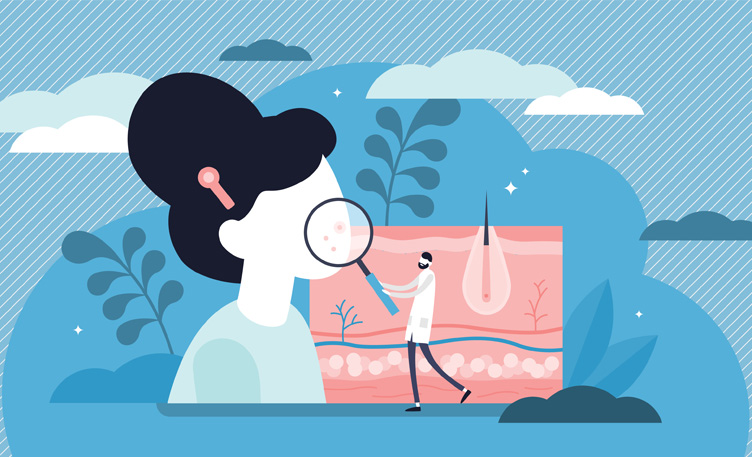Everything about Common Skin Disorders

Skin infections are conditions affecting the skin. These are diseases that can cause inflammation, itchiness, rashes, and other skin changes. Certain skin conditions are genetic, while there are others caused due to lifestyle factors. Treatment for different skin conditions includes ointments, creams, medications, and lifestyle changes.
What Are Skin Diseases?
The skin is a large organ covering and protecting the human body. It serves varied functions like:
- Holding in fluid and preventing dehydration
- Keeping out viruses, bacteria, and other causes of diseases
- Helping you feel different sensations, like pain or temperature
- Synthesising vitamin D
- Stabilising body temperature
Issues of the skin include all those conditions that inflame, clog, and irritate the skin causing rashes, and other changes in the skin appearance.
Skin diseases contribute to 1.79% of the universal burden of diseases across the world. According to the American Academy of Dermatology Association. 1 in 4 individuals in the US has skin issues.
Skin diseases can greatly vary in severity and symptoms, and they can be permanent or temporary, painful or painless. Some skin infections can be minor, while others can be life-threatening.
Common Types of Skin Problems
A few common types of skin problems are as follows:
- Acne: blocked skin follicles result in dead skin, oil, and bacteria build-up in the pores.
- Atopic dermatitis or eczema: Itchy and dry skin resulting in scaliness, cracking and swelling.
- Alopecia Areata: Losing hair in small patches
- Raynaud’s phenomenon: This condition entails the periodic reduced flow of blood to the toes, fingers, and other body parts, causing skin numbness and colour change.
- Psoriasis: Scaly skin that may feel hot or swell.
- Skin Cancer: The uncontrolled growth of abnormal skin cells.
- Rosacea: Thick, flushed pimples and skin on the face.
- Vitiligo: Skin patches that lose their pigment.
Rare Skin Conditions
Rare skin conditions are generally genetic, which means a person inherits them. These include:
- Chromhidrosis or coloured sweat.
- Argyria: Changes in the colour of the skin because of silver build-up in the body.
- Actinic Prurigo: Itchy rashes caused due to sun exposure
- Harlequin Ichthyosis: Hard and thick plates or patches on the skin present from birth.
- Epidermolysis Bullosa: Disorder of the connective tissue causing fragile skin that easily tears and blisters.
- Lamellar Ichthyosis: Waxy skin layer that sheds in a newborn after a few weeks of life, revealing red and scaly skin.
- Necrobiosis lipoidica: Skin rashes on the lower legs with chances of developing into sores or ulcers.
Symptoms of Different Skin Disorders
The symptoms of skin disorders can greatly vary depending on the condition you are suffering from. Changes in your skin are not always the result of diseases or infections. Sometimes, ill-fitting shoes or clothes can also cause blisters. Nevertheless, when the skin condition changes without any known cause, it might be linked to a certain underlying condition.
Some common symptoms of skin diseases include:
- Dry skin.
- Discoloured skin patches or abnormal pigmentation.
- Peeling skin.
- Open ulcers, lesions or sores.
- White, red or pus-filled bumps on the skin.
- Rashes caused by itchiness.
- Rough and scaly skin.
Causes of Skin Problems
Some of the most common causes of skin problems include:
- Viruses.
- Bacteria trapped in the hair follicles and skin pores.
- Microorganisms, parasites, or fungi living on the skin.
- Genetic factors.
- Weak immune system.
- Different illnesses affect the kidneys, immune system, thyroid, and other body parts.
- Contact with irritants, allergens or individuals with infected skin.
Health Conditions Leading to Higher chances of Skin Diseases
Different health conditions can result in skin disorders, whereas certain skin conditions do not have any known cause.
Diabetes: People suffering from diabetes can experience skin various problems because of blood circulation issues:
- Acanthosis nigricans.
- Bacterial infections like styes, folliculitis, and boils.
- Diabetic dermopathy.
- Fungal infections like ringworm, athlete’s foot, and different yeast infections.
- Diabetic blisters.
- Digital sclerosis.
Inflammatory Bowel Disease: This is one collective term used for describing different intestinal problems that can result in the prolonged inflammation of the digestive tract. Most often, these bowel-related issues, and even the medicines used for treating them, can result in skin problems, like:
- Anal fissures.
- Skin tags.
- Allergic eczema.
- Vasculitis.
- Stomatitis.
- Vitiligo.
Lupus: This is a serious inflammatory disease causing organ, joint and skin damage, like:
- Red, thick and scaly lesions.
- Round lesions on the head and face.
- Ring-shaped, red lesions on the parts of the body exposed to the sun.
- Black, red or purple spots on toes and fingers.
- Flat rash on body and face that appears like a sunburn.
- Small red spots on legs.
- Sores within the nose and mouth.
Conclusion
While it is good to learn to differentiate between the varied skin diseases, the key here is receiving proper diagnosis and treatment from a dermatologist. Yes, while the majority of the skin diseases are minor, others indicate more serious issues and require the help of a healthcare professional.
Book an appointment with a skincare specialist at Medanta and talk it out with the professional to determine the best treatment plan for your skin problem.






